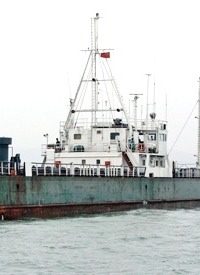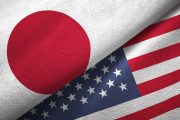
A U.S. Navy guided missile destroyer, the USS John S. McCain, has been tailing the North Korean ship. Additionally, the Japanese Coast Guard reported that the Pyongyang regime has banned ships from a large area off its east coast, warning that military drills would be conducted off its eastern port of Wonsan between June 25 and July 10. This latest announcement has increased speculation that the North is preparing for further missile launches.
The Japanese media have reported that the North Koreans appear to be preparing for a long-range missile test around July 4, and a Japanese defense ministry paper has developed a scenario wherein Pyongyang could fire a missile towards Hawaii. President Barack Obama addressed this possible threat during an interview with CBS News’s Harry Smith taped on June 19 and broadcast June 22 on The Early Show. "This administration and our military is fully prepared for any contingencies," Obama said during the interview . "I don’t want to speculate on hypotheticals," the president continued, "But I want … to give assurances to the American people that the t’s are crossed and the i’s are dotted in terms of what might happen."
"What we’re not going to do is to reward belligerence and provocation in the way that’s been done in the past," said the president.
Following the president’s statement, North Koreans responded with strong rhetoric of their own. "As long as our country has become a proud nuclear power, the US should take a correct look at whom it is dealing with," said a commentary in Rodong Sinmun, the official newspaper of North Korea’s communist party. "It is a grave mistake for the US to think it will not be hurt if it ignores this and ignites the fuse of war on the Korean Peninsula," said the article.
The current round of tense actions and reactions between Pyongyang and the West began when North Korea launched its Taepodong-2 long-range missile on April 5, a move President Obama called "provocative" and a "clear violation" of Security Council Resolution 1718.
Following the April 5 missile launch and North Korea’s May 25 nuclear test, the United Nations Security Council on June 12 unanimously approved stringent new sanctions against North Korea, including a tighter arms embargo and new financial restrictions. The council also demanded that North Korea "not conduct any further nuclear test or any launch using ballistic missile technology" and imposed a series of measures on North Korea, including tougher inspections of cargo suspected of containing banned items related to the country’s nuclear and ballistic missile activities, a tighter arms embargo with the exception of light weapons, and new financial restrictions.
Both Pyongyang’s expected July missile test and the voyage of the Kang Nam to Myanmar are considered to be blatant violations of these sanctions. A senior U.S. military official told the Associated Press on condition of anonymity on June 19 that the USS John S. McCain was relatively close to the Kang Nam, but had no orders to intercept it.
Senator John McCain said on CBS’ Face the Nation on June 21 that U.S. sailors should board the Kang Nam even without North Korean permission if hard evidence shows that the ship is carrying missiles or other cargo in violation of UN resolutions. (The pertinent Security Council resolution only allows UN member states to inspect vessels with the consent of the nation whose flag the ship is flying.) "I think we should board it. It’s going to contribute to the proliferation of weapons of mass destruction to rogue nations that pose a direct threat to the United States," said the Arizona senator and former GOP presidential candidate.
Meanwhile, the Japanese speculation about the possible target of North Korea’s expected missile launch has produced some concern in Hawaii, where the memory of Japan’s 1941 attack against Pearl Harbor is firmly ingrained in the state’s consciousness.
While the possibility of North Korean missile inflicting harm against Hawaii is remote, military officials apparently were not dismissing the threat lightly. AP reported that on June 17, the Navy moved an X-band military radar system from Hawaii’s coast out to sea. The radar is designed to work with ground-based missile interceptors on the island of Kauai to intercept and destroy ballistic missiles.
The military has tested two missile defense systems at the Pacific Missile Range Facility on Kauai — the land-based Terminal High Altitude Area Defense system and the sea-based Aegis system. "We’re in a good position should it become necessary to protect American territory," Pacific Fleet Lt. Cmdr. Chuck Bell was quoted by AP.
Such a position is an excellent one to be in, since protecting American territory is the sole purpose of our military forces. All too often in the past, our military has become bogged down in protecting other nations’ territory.
Photo of Kang Nam: AP Images



